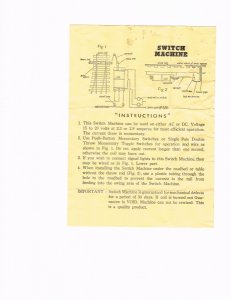Hi: My name is Harry L. Friend and I need the wireing diagram for a Ken Kidder switch machine. Any help will be appreaceted.
ken kidder switch machine
- Thread starter Harrylfriend
- Start date
You are using an out of date browser. It may not display this or other websites correctly.
You should upgrade or use an alternative browser.
You should upgrade or use an alternative browser.
Welcome to The Gauge, Harry. I've never heard of the Ken Kidder switch machine, but I'm giving this thread a bump in case someone else knows about them.
I'm assuming the Ken Kidder switch machines are twin coil switch machines, similar to the old Kemtron or NJ machines. The Kidder machine may or may not have auxiliary contacts for controlling frog polarity, indicator lights, and/or signals. But the machine itself is almost always a standard 3 wire configuration.
The 2 outside wires generally go to each coil, and should have a push button switch between the coil and one side of the power supply. The center terminal or wire is common to both wires and goes to the other side of the power supply. Power can be AC or DC, 12-20 volts. These machines typically draw about 2 amps for a fraction of a second (it needs to be kept to a fraction of a second to avoid releasing the magic smoke). Which is why momentary push buttons are used to control each coil.
Hope this helps. A picture would confirm or deny my assumption of a twin coil machine.
The 2 outside wires generally go to each coil, and should have a push button switch between the coil and one side of the power supply. The center terminal or wire is common to both wires and goes to the other side of the power supply. Power can be AC or DC, 12-20 volts. These machines typically draw about 2 amps for a fraction of a second (it needs to be kept to a fraction of a second to avoid releasing the magic smoke). Which is why momentary push buttons are used to control each coil.
Hope this helps. A picture would confirm or deny my assumption of a twin coil machine.
Dont you just hate that smoke thingy if you press the button for the coil too long. Has anyone ever come up with a better idea than the dcc version? This idea could just be a money maker for those not wanting to go via dcc. Perhaps an electronic oneshot version after the pushbutton just before the coil. this accompanied with an LED status indicator.
Dont you just hate that smoke thingy if you press the button for the coil too long. Has anyone ever come up with a better idea than the dcc version? This idea could just be a money maker for those not wanting to go via dcc. Perhaps an electronic oneshot version after the pushbutton just before the coil. this accompanied with an LED status indicator.
Use a capacitive discharge unit to power the twin coils, and you will never smoke one again. Won't even smoke even if the button gets stuck in the on position. Build your own (very simple) from a circuit on the web or buy a commercial unit from Circuitron.
Thanks folks. These are two coil machines with 5 connections. You're right about the capicitive discharge unit especially with a heavy momentary current draw. Harry From Beatty Nevada
Thanks
These are 2 coil machines with 5 connections. I will am going to use capacitive discharge units because of the heavy momentary current draw. Thanks for the info. Harry L. Friend
These are 2 coil machines with 5 connections. I will am going to use capacitive discharge units because of the heavy momentary current draw. Thanks for the info. Harry L. Friend
These are 2 coil machines with 5 connections. I will am going to use capacitive discharge units because of the heavy momentary current draw. Thanks for the info. Harry L. Friend
There should be a 6th (and possibly 7th connection somewhere) or just 4. Connections as follows:
2 wires to each coil. Almost always, one wire from each coil is tied together for a total of 3 connections instead of 4. The common wire (or one wire from each coil) goes directly to one side of the power supply (CD unit if you are using one). The common wire could be tied to the switch machine frame, which is why you don't see it as a separate connection. The other wire from each coil goes to the push button(s) for that controller.
The auxiliary SPDT contact (assuming there is one) has 3 connections. Usually the auxiliary contact is used to power the frog, but can really be used for just about anything that doesn't draw a lot of current. If used to power the frog, the center blade of the contact is wired to the frog. The 2 positions are wired to the stock rails or power bus to give th frog the correct polarity, depending on which way the turnout is thrown.
hope this helps
Ken Kidder Switch Machine Instructions
Hi Harry,
I just joined the forum and noticed your post. You have probably already received the info you wanted, but just in case, here is a scan of the original Ken Kidder switch machine instructions, dating back to the 60s. Hope this helps.
-Dave

Hi: My name is Harry L. Friend and I need the wireing diagram for a Ken Kidder switch machine. Any help will be appreaceted.
Hi Harry,
I just joined the forum and noticed your post. You have probably already received the info you wanted, but just in case, here is a scan of the original Ken Kidder switch machine instructions, dating back to the 60s. Hope this helps.
-Dave


